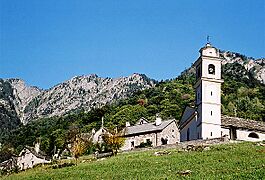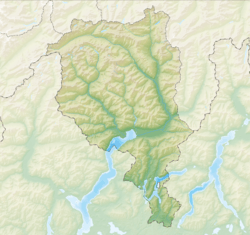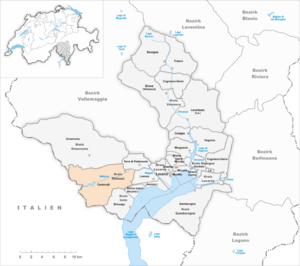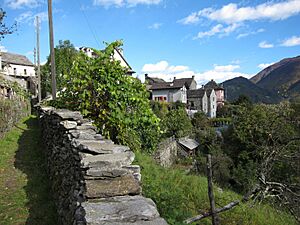Centovalli facts for kids
Quick facts for kids
Centovalli
|
||
|---|---|---|
 |
||
|
||
| Country | Switzerland | |
| Canton | Ticino | |
| District | Locarno | |
| Area | ||
| • Total | 53.5 km2 (20.7 sq mi) | |
| Elevation | 708 m (2,323 ft) | |
| Population
(Dec 2020 )
|
||
| • Total | 1,135 | |
| • Density | 21.215/km2 (54.95/sq mi) | |
| Postal code |
6657
|
|
Centovalli (which means "hundred valleys") is a beautiful valley and a municipality in Switzerland. It's located in the Ticino region, near Locarno. This area is made up of 19 small villages or hamlets called "frazioni". The current municipality of Centovalli was created on October 25, 2009. It was formed by joining three older municipalities: Borgnone, Intragna, and Palagnedra.
Contents
A Look at History
The villages that make up Centovalli have a long history. Intragna was first mentioned in records in 1272. Camedo appeared in 1294, Borgnone in 1364, and Palagnedra in 1379. These dates show how old these settlements are!
Borgnone's Past
In the Middle Ages, Borgnone was part of the larger Locarno area. It became its own independent municipality in 1838.
The Church of Beata Vergine dell'Assunta was built here between 1364 and 1365. Over the years, it has been changed and updated many times.
People in Borgnone traditionally earned money from farming and raising animals. Many also traveled away for part of the year to find work. Today, most people work in service jobs, and many homes are used for vacations. A railway line connecting Locarno and Domodossola was finished in 1923, making travel easier.
Intragna's Story
Archaeologists found old graves in Intragna from before the Roman times. This shows that people lived here over 3,000 years ago!
In the Middle Ages, different powerful groups, like the Bishop of Como, owned land here. Intragna, along with Golino and Verdasio, formed a local community. They had their own rules, first written in 1365.
The Church of S. Nome di Maria was built in Intragna between 1722 and 1738. Its bell tower, added later, is 65 meters (213 feet) tall. It is the tallest bell tower in the entire Ticino region!
For a long time, farming and animal raising were the main ways to make a living. Starting in the 1500s, many people would travel to other areas, like Lombardy and Piedmont, to work as chimney sweeps. Later, in the 1800s, many people moved overseas to America and Australia. Local factories, like a watch factory and a shoe factory, closed down in the 1960s.
A main road was built between 1889 and 1893. In 1923, a train station opened on the Locarno-Domodossola railway line. Some villages, like Rasa, can only be reached by cable car. Intragna is also home to the Regional Museum for the Centovalli, which opened in 1989.
Palagnedra's Heritage
In the Middle Ages, Palagnedra was an important center for the Centovalli valley. It became an independent village in 1864.
The Church of San Michele was built between 1640 and 1732. It has beautiful old frescoes (wall paintings) from the late Gothic period. These paintings are some of the best preserved in the area.
People in Palagnedra traditionally farmed and grazed animals. From the 1500s, some people traveled to Italy for seasonal work, often as cooks. Until the 1950s, some people also earned money through smuggling goods across the nearby Swiss-Italy border. A hydroelectric dam was built here between 1950 and 1952, which generates electricity.
On October 25, 2009, Palagnedra joined with Borgnone and Intragna to form the new municipality of Centovalli.
Centovalli's Coat of Arms
The current coat of arms for Centovalli was chosen in 2009. It features the letters C and V, which stand for Centovalli. The design uses green and gold colors, with a capital C shape representing the valley and water.
Geography and Location
Centovalli covers an area of about 51.39 square kilometers (nearly 20 square miles). A large part of this area, about 76.8%, is covered by forests. About 4.1% is used for farming. The rest includes buildings, roads, rivers, lakes, and rocky, unproductive land.
The municipality is located in the Centovalli valley itself. This valley was carved out by the Melezza river. The name "Centovalli" suggests there are 100 smaller valleys joining the main one. The western edge of the municipality is the border between Switzerland and Italy.
Centovalli includes many villages and hamlets. Some of these are Borgnone, Intragna, Palagnedra, Costa, Lionza, Golino, Verdasio, Rasa, and Camedo. Camedo is on the valley floor and has a customs station and a train station.
Population and People
Centovalli has a population of about 1,183 people (as of 2017). In 2008, about 45.4% of the population were male and 54.6% were female.
Looking at the age groups in 2009:
- About 5.1% of the people were children aged 0-9.
- About 7.7% were teenagers aged 10-19.
- About 13.3% were young adults aged 20-29.
- About 17.2% were older adults aged 60-69.
- About 7.4% were over 80 years old.
Most people in Centovalli speak Italian. Some also speak German.
Religion in Centovalli
Most people in Centovalli are Roman Catholic. In 2000, about 73.7% of people in Intragna were Roman Catholic. A smaller number, about 11.6%, belonged to the Swiss Reformed Church. Similar patterns were seen in Borgnone and Palagnedra.
Homes and Housing
In 2000, most buildings in Centovalli were single-family homes. For example, in Intragna, about 83.2% of the inhabited buildings were single-family homes. Many homes in the area are used seasonally, meaning they are vacation homes or second homes. In Intragna, about 54.6% of apartments were used seasonally.
Historical Population Changes
The population of these villages has changed a lot over time. Here’s a look at how many people lived in Borgnone, Intragna, and Palagnedra in different years:
| Year | Population Borgnone |
Population Intragna |
Population Palagnedra |
|---|---|---|---|
| 1591 | 13 Households | - | - |
| 1653 | - | 604 | - |
| 1764 | - | Over 1,000 | - |
| 1801 | 290 | 936 | - |
| 1850 | 409 | 1,428 | 337 |
| 1900 | 393 | 1,240 | 267 |
| 1950 | 307 | 957 | 298 |
| 1970 | - | 841 | - |
| 2000 | 143 | 915 | 92 |
Education System
In 2009, Centovalli had a total of 126 students. The education system in Ticino includes:
- Kindergarten: Up to three years, but it's not required. In Centovalli, 17 children were in kindergarten.
- Primary School: This lasts for five years. There were 35 students in standard primary schools.
- Lower Secondary School: Students either go to a two-year middle school or a four-year program to prepare for higher education. There were 41 students in middle school and 9 in the advanced program.
- Upper Secondary School: This prepares students for a trade or for college/university. Students can attend school while doing an internship. There were 5 full-time and 15 part-time vocational students.
- Professional Program: This three-year program prepares students for jobs in fields like engineering or nursing. Three students were in this program.
Important Heritage Sites
The Parish Church of S. Michele and its main square are very important historical sites in Switzerland. They are considered a "heritage site of national significance."
Also, several villages in Centovalli are listed as part of the "Inventory of Swiss Heritage Sites." These include Borgnone, Costa, Golino, Intragna, Lionza, Palagnedra, Rasa, Verdasio, and Bordei. This means they have special historical or cultural value.
Economy and Tourism
In 2009, Centovalli had 7 hotels with a total of 64 rooms and 133 beds. Tourism is an important part of the local economy.
See also
 In Spanish: Centovalli para niños
In Spanish: Centovalli para niños











